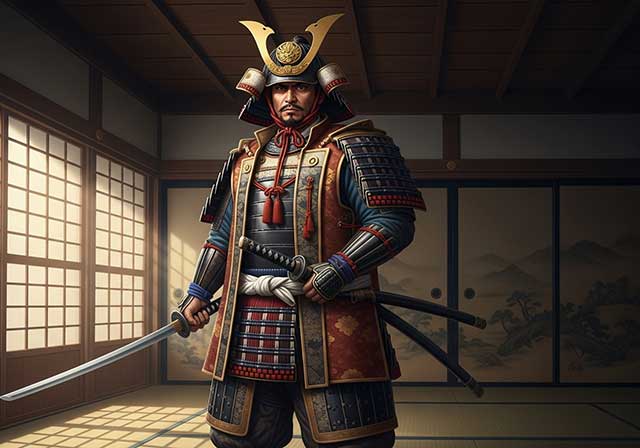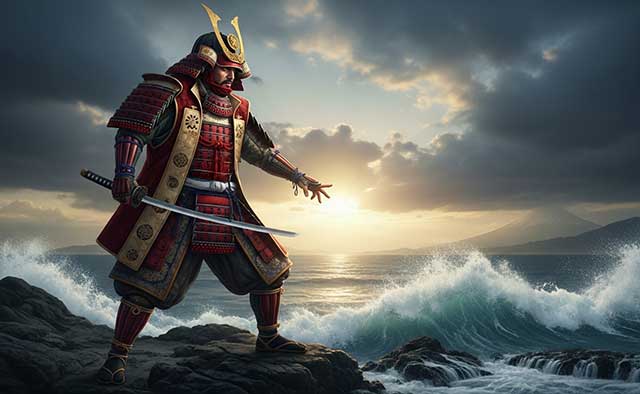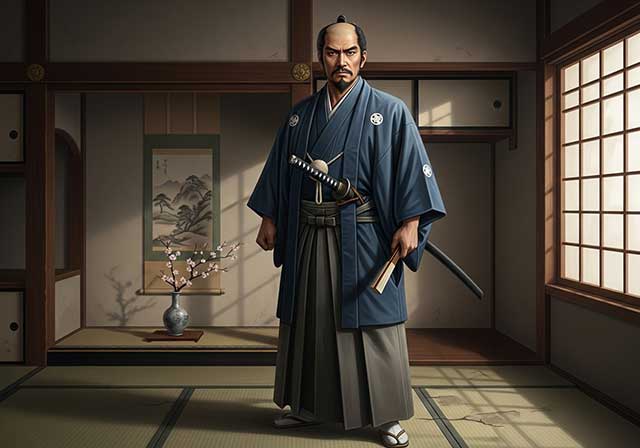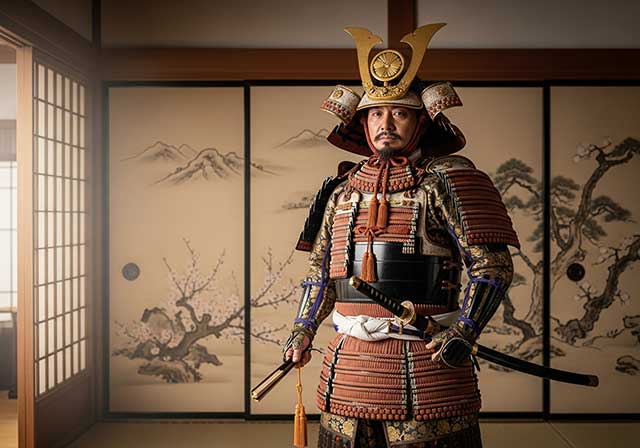
Fukushima Ichimatsu was born in 1561, in Futatsudera, Kaitō, Owari Province (present-day Ama, Aichi Prefecture), as the eldest son of barrel merchant Fukushima Masanobu. His mother was the younger sister of Toyotomi Hideyoshi's mother, making Hideyoshi his first cousin.
His first foray into battle took place during the assault on Miki Castle in 1578-1580 in Harima Province. Following the Battle of Yamazaki in 1582, he was rewarded with a 500 koku stipend. In 1583, at the Battle of Shizugatake, he achieved a notable victory over the prominent samurai Haigo Gozaemon. During this battle, Masanori earned the distinction of taking the first head, that of the enemy general Ogasato Ieyoshi. This accomplishment led to a significant increase in his stipend by 5000 koku (while the other each received 3000 Koku). Subsequently, he entered into marriage with Omasa.
Masanori actively participated in many of Hideyoshi's campaigns. It wasn't until after the Kyūshū Expedition in 1587 that he was granted the title of daimyō. He was granted the fief of Imabari in Iyo Province, with an income assessed at 110,000 koku. Shortly thereafter, he played a key role in the Korean Campaign, particularly distinguishing himself by capturing Ch'ongju in 1592.
Following his involvement in the Korean campaign, Masanori took part in the pursuit of Toyotomi Hidetsugu. In 1595, he led a force of 10,000 men, surrounding Seiganji temple on Mount Kōya, and maintained his position until Hidetsugu's eventual suicide. With Hidetsugu's demise, Masanori's stipend saw a substantial increase of 90,000 koku. He also acquired Hidetsugu's former fief of Kiyosu in Owari Province.
In the pivotal year of 1600, Masanori aligned himself with Tokugawa Ieyasu's 'Eastern army' during the Battle of Sekigahara. Later in September, he played a significant role in the Battle of Gifu Castle against Oda Hidenobu of the Ishida Mitsunari western forces, which served as a prelude to the Battle of Sekigahara the following month.
During the main Battle of Sekigahara, Masanori led the Tokugawa advance guard. He initiated the battle, charging north from the Eastern Army's left flank along the Fuji River, directly attacking the Western Army's right center. Masanori's forces engaged in a fierce and bloody confrontation with Ukita Hideie's army, which initially gained the upper hand, pushing back Masanori's troops. However, the pivotal defection of Kobayakawa Hideaki to support the Eastern army forced other units into betrayal. Subsequently, Masanori's forces turned the tide and secured victory for the Eastern Army.
Post-Sekigahara, Masanori took measures to safeguard his domain. Although he later experienced the loss of his holdings, his descendants went on to become hatamoto in the service of the Tokugawa shōgun.
Shortly after the passing of Ieyasu in 1619, Masanori faced accusations of violating the Buke Shohatto by undertaking repairs on a small section of Hiroshima Castle, which had been damaged in a typhoon-induced flood, without official authorization. Despite having submitted a request for permission two months prior, he had not received formal approval from the bakufu. It is believed that he only repaired the leaky section out of necessity. While the matter was initially resolved with the condition that Masanori, who was fulfilling his duty in Edo, would apologize and remove the repaired parts of the castle, the bakufu later accused him of inadequate removal of those parts. Consequently, his territories in Aki and Bingo Provinces, valued at 500,000 koku, were confiscated. In lieu of this, he was granted Takaino Domain, one of four counties in Kawanakajima, Shinano Province, and Uonuma County, Echigo Province, with an assessed value of 45,000 koku. He passed away at the age of 63 in 1624. His descendants continued to serve as Hatamoto in the employ of the Tokugawa Shogunate.
See also
-
Otomo Sorin

Ōtomo Yoshishige came from a noble lineage, being the eldest son of Ōtomo Yoshiaki, the ruler of Funai Province. The roots of the Ōtomo family traced back to Fujiwara Hidesato, the adopted son of Nakahara Chikayoshi. Fujiwara served Minamoto Yoritomo during the Genpei War and took part in battles in Mutsu Province in 1189. In 1193, he was appointed shugo of Buzen and Bungo Provinces, after which he adopted a new surname—Ōtomo.
-
Okudaira Sadamasa

Sadamasa was the son of Okudaira Sadayoshi and took part in several battles under Tokugawa Ieyasu, distinguishing himself in the Battle of Anegawa in 1570, where he took two heads. Around 1572 he was forced to enter the service of the Takeda clan, but after the death of Takeda Shingen in 1573 he returned to Tokugawa, leaving Tsukude Castle together with his men. As a result of this defection, Takeda Katsuyori ordered the execution of Sadamasa’s wife and brother, who were being held as hostages.
-
Okubo Tadatika

Tadatika, the son of Okubo Tadayō, entered the service of Tokugawa Ieyasu at the age of eleven, and took his first head in battle when he was sixteen. After the establishment of the Tokugawa shogunate, he was appointed as a rōjū — a senior bakufu official — and was regarded as one of Ieyasu’s most trusted advisors, alongside Honda Masanobu. He is also known for his military chronicle Mikawa Monogatari, which describes Ieyasu’s rise to power and the early years of the Tokugawa shogunate.
-
Okubo Nagayasu

Nagayasu was the second son of Okura Nobuyasu, a sarugaku theater actor from the Takeda clan. Takeda Shingen recognized the young man’s potential and took him into service, appointing him as a vassal to his general, Tsuchiya Masatsugu. During this period, Nagayasu changed his family name to Tsuchiya. He was entrusted with developing the Takeda clan’s gold mines as well as handling matters related to taxation.
-
Nitta Yoshisada

Nitta Yoshisada was a loyal soldier of Emperor Go-Daigo, who in the 1330s attempted to restore direct imperial rule in Japan. The Nitta family was related to the Ashikaga house and was older in lineage. However, they did not join Minamoto Yoritomo at the start of his war with the Taira, as the Ashikaga did, and therefore did not receive high positions in the Kamakura shogunate. This may have been one of the reasons why Yoshisada rose against the Hōjō clan in 1333.
-
Natsume Yoshinobu

Yoshinobu, a long-time vassal of the Matsudaira and Tokugawa clans, governed Hamamatsu Castle on behalf of the Tokugawa house. During the clashes between the Imagawa, Takeda, and Matsudaira clans, he served in the garrison of Nagasawa Castle and in 1562 took part in raids under the command of Itakura Shigezane. When, in 1563, a revolt of the Sōtō-shū sect followers broke out in Mikawa Province, Yoshinobu joined the rebels together with Honda Masanobu and Hachiya Sadatsugu.
-
Nambu Nobunao

The Nambu clan was an ancient and powerful family that traced its lineage back to the Minamoto shoguns and had controlled a significant part of the Tohoku region in northern Honshu since the 12th century. Nobunao was born in Ikatai Castle, located in what is now the city of Iwate. He was the second son of Ishikawa (Nambu) Takanobu, the 22nd head of the Nambu clan. In 1565, Nobunao’s uncle, Nambu Harumasa, adopted him, brought him to Sannohe Castle, and named him his heir, later giving his daughter in marriage to him.
-
Naito Ienaga

Ienaga was the son of Naitō Kiyonaga and served Tokugawa Ieyasu from an early age. Like his father, he was exceptionally brave, and thanks to his remarkable skill with the bow, he earned the nickname “the unrivaled archer.” Although both the elder and the younger Naitō belonged to the Jōdo Shinshū (“True Pure Land”) sect, during the Ikkō-ikki uprising in Mikawa Province in 1565, Ienaga did not support his fellow believers and instead sided with Tokugawa Ieyasu, earning his special trust. He later took part in the battles of Mikatagahara, Nagashino, and many other engagements while accompanying Ieyasu.

